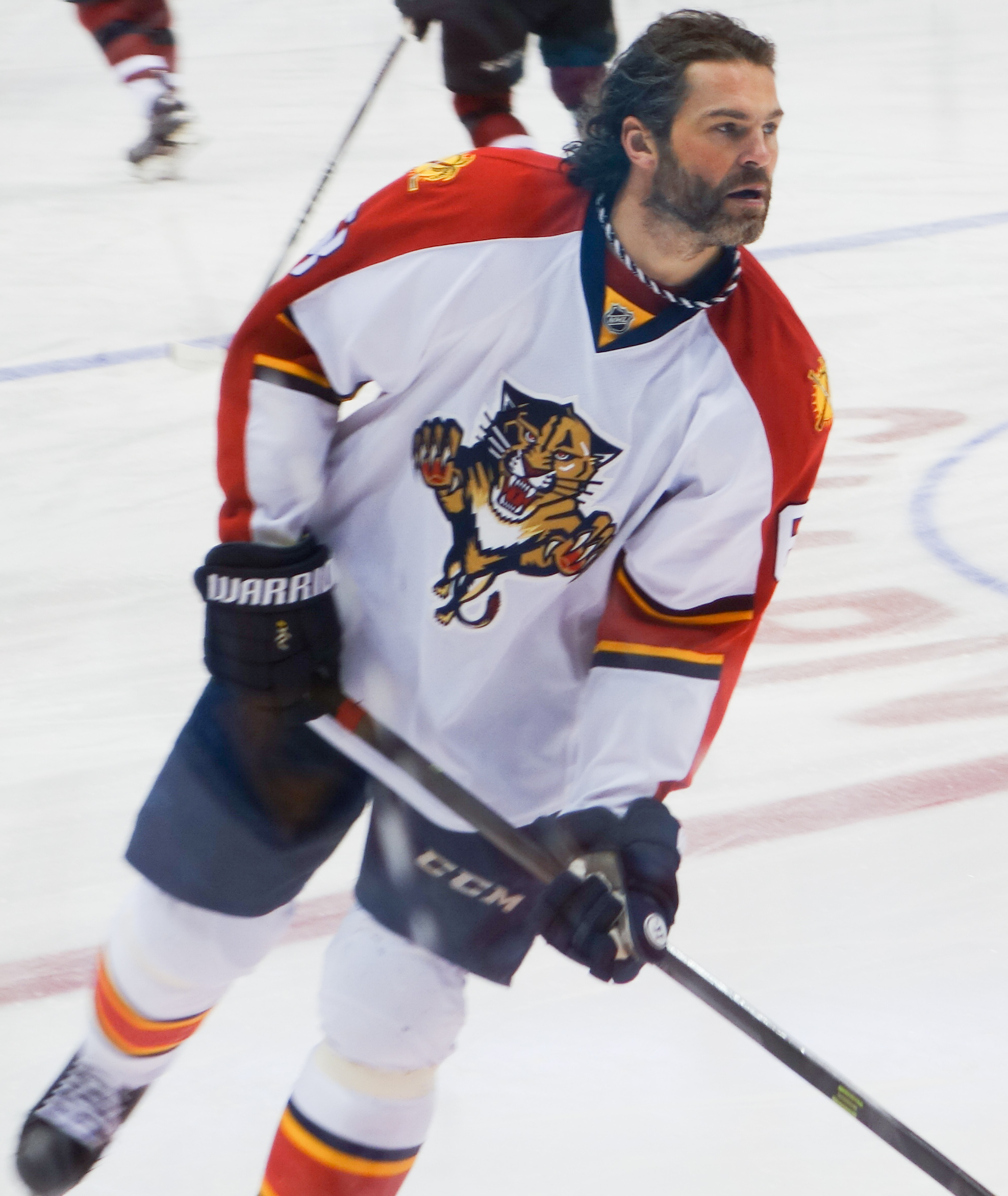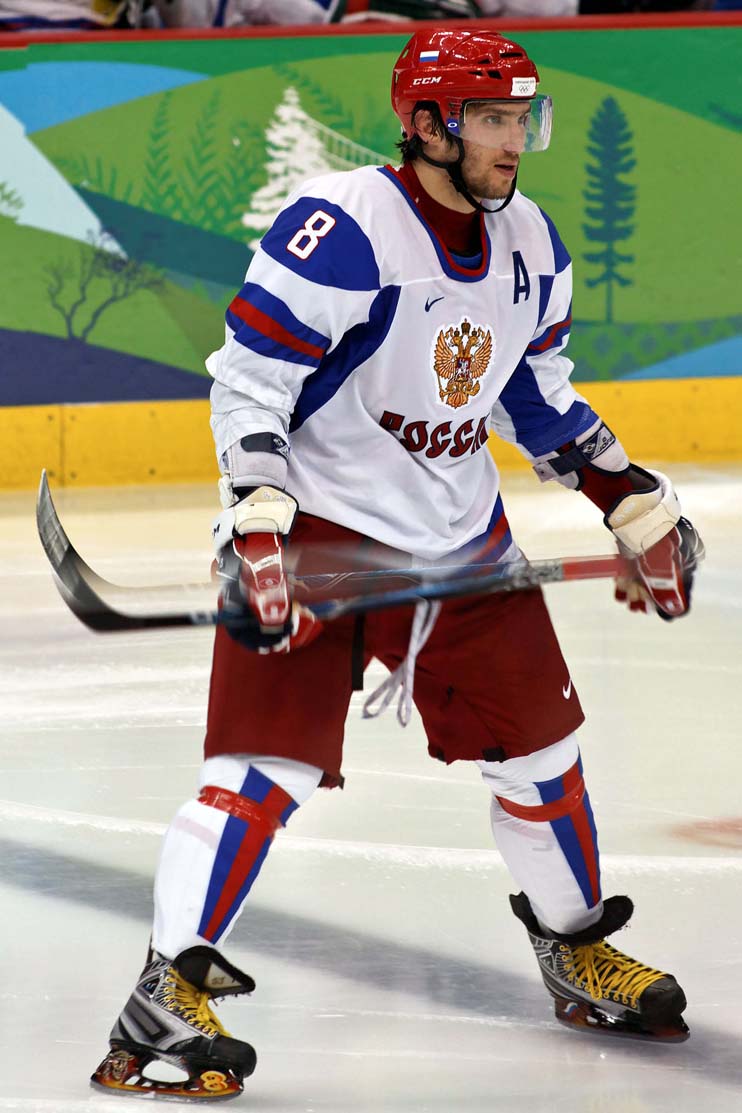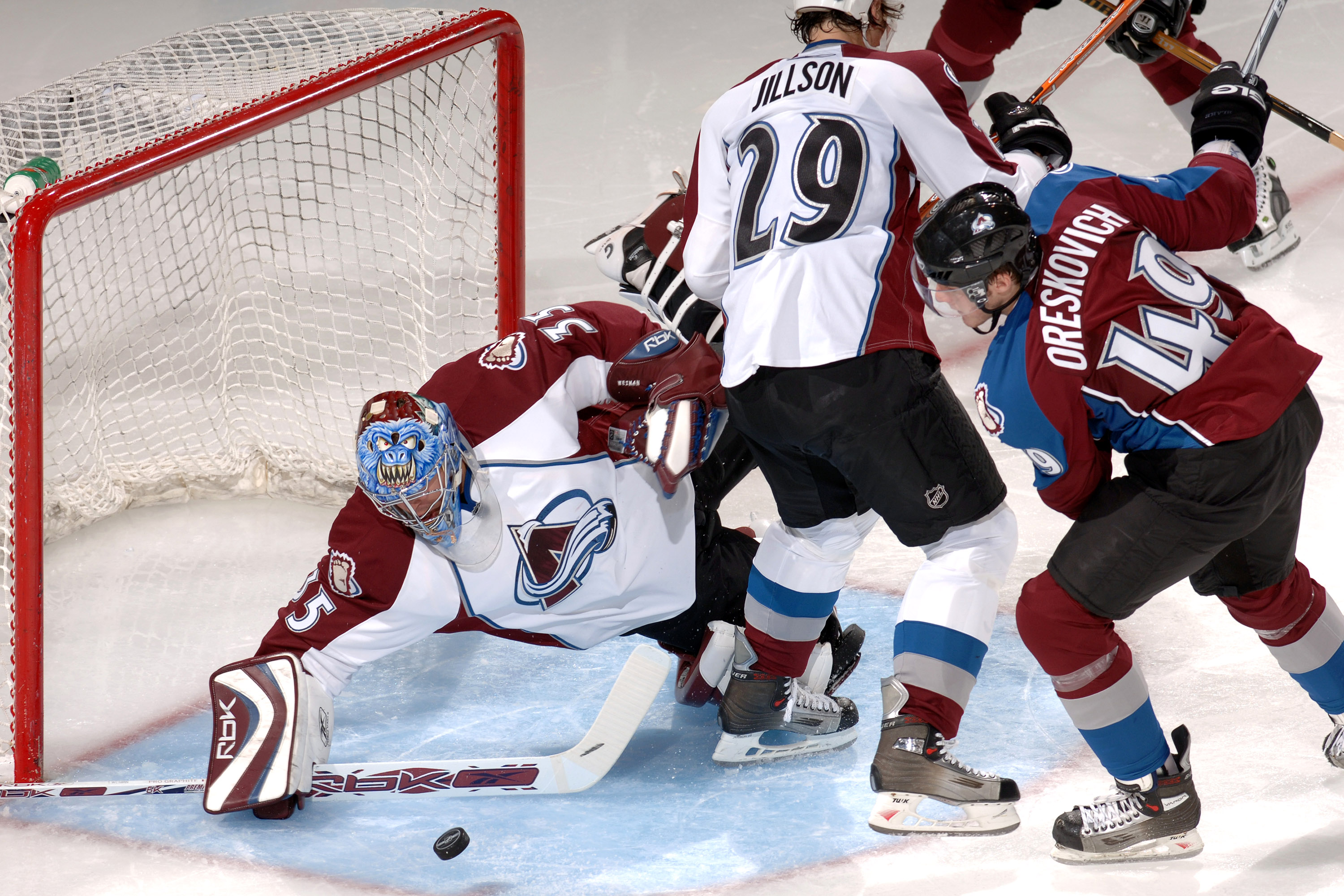|
Forward (hockey)
In ice hockey, a forward is a player, and a position on the ice, whose primary responsibility is to score and assist goals. Generally, the forwards try to stay in three different lanes of the ice going from goal to goal. It is not mandatory, however, to stay in a lane. Staying in a lane aids in forming the common offensive strategy known as a triangle. One forward obtains the puck and then the forwards pass it between themselves making the goalie move side to side. This strategy opens up the net for scoring opportunities. This strategy allows for a constant flow of the play, attempting to maintain the control of play by one team in the offensive zone. The forwards can pass to the defence players playing at the Blue line (ice hockey), blue line, thus freeing up the play and allowing either a shot from the point (blue line position where the defence stands) or a pass back to the offence. This then begins the triangle again. Forwards also shared defensive responsibilities on the ic ... [...More Info...] [...Related Items...] OR: [Wikipedia] [Google] [Baidu] |
Ice Hockey
Ice hockey (or simply hockey) is a team sport played on ice skates, usually on an ice skating rink with lines and markings specific to the sport. It belongs to a family of sports called hockey. In ice hockey, two opposing teams use ice hockey sticks to control, advance and shoot a closed, vulcanized, rubber disc called a " puck" into the other team's goal. Each goal is worth one point. The team which scores the most goals is declared the winner. In a formal game, each team has six skaters on the ice at a time, barring any penalties, one of whom is the goaltender. Ice hockey is a full contact sport. Ice hockey is one of the sports featured in the Winter Olympics while its premiere international amateur competition, the IIHF World Championships, are governed by the International Ice Hockey Federation (IIHF) for both men's and women's competitions. Ice hockey is also played as a professional sport. In North America as well as many European countries, the sport is known simply ... [...More Info...] [...Related Items...] OR: [Wikipedia] [Google] [Baidu] |
Blue Line (ice Hockey)
An ice hockey rink is an ice rink that is specifically designed for ice hockey, a competitive team sport. Alternatively it is used for other sports such as broomball, ringette, rinkball, and rink bandy. It is a rectangle with rounded corners and surrounded by walls approximately high called the ''boards''. Name origins ''Rink'', a Scots word meaning 'course', was used as the name of a place where another game, curling, was played. Early in its history, ice hockey was played mostly on rinks constructed for curling. The name was retained after hockey-specific facilities were built. Dimensions There are two standard sizes for hockey rinks: one used primarily in North America, also known as NHL size, the other used in Europe and international competitions, also known as IIHF or Olympic size. International Hockey rinks in the rest of the world follow the International Ice Hockey Federation (IIHF) specifications, which are with a corner radius of . The two goal lines ... [...More Info...] [...Related Items...] OR: [Wikipedia] [Google] [Baidu] |
Winger (ice Hockey)
Winger, in the game of ice hockey, is a forward position of a player whose primary zone of play is along the outer playing areas. They typically flank the centre forward. Originally the name was given to forward players who went up and down the sides of the rink. Wingers generally have the least defensive responsibilities out of any position on the ice, however they are still tasked with defensive duties such as forechecking duties or covering the point in the defensive zone. Nowadays, there are different types of wingers in the game — out-and-out goal scorers, checkers who disrupt the opponents, and forwards who work along the boards and in the corners. Often a winger's precise role on a line depends upon what type of role the other winger plays; usually lines will have one more goal-scoring oriented winger and one winger more focused on playing the boards, checking and passing the puck to others to take shots (if a larger player, he will sometimes be called a "power forward ... [...More Info...] [...Related Items...] OR: [Wikipedia] [Google] [Baidu] |
Centre (ice Hockey)
The centre (or center in the United States) in ice hockey is a forward (hockey), forward position of a player whose primary Hockey rink#Zones, zone of play is the middle of the ice, away from the sideboards. Centres have more flexibility in their positioning and therefore often end up covering more ice surface than any other player. Centres are ideally strong, fast skaters who are able to Checking (ice hockey), back-check quickly from deep in the opposing zone. Generally, centres are expected to be gifted passers more so than goal scorers, although there are exceptions - typically larger centres who position themselves directly in front of the net in order to score off rebounds. They are also expected to have exceptional "ice vision", intelligence, and creativity. They also generally are the most defensively-oriented forwards on the ice, as they are expected to play the role of the third player in defense, after the defenceman, defencemen. Centres usually play as part of a line ( ... [...More Info...] [...Related Items...] OR: [Wikipedia] [Google] [Baidu] |
Rover (ice Hockey)
A rover was a position in ice hockey used from its formation in the late nineteenth and early twentieth century. At the time ice hockey consisted of seven positions: along with the goaltender, two defencemen, and three forwards, positions which still remain. Unlike all the others, the rover did not have a set position, and roamed the ice at will, going where needed. As the skill level of players increased, the need to have a rover decreased. Shortly after it was formed in 1910, the National Hockey Association decided to exclude the rover. The league's successor, the NHL, did the same in 1917. However, the Pacific Coast Hockey Association, formed in 1911, kept the rover. The Western Canada Hockey League also used a rover when it was founded in 1921. As the NHA and later NHL did not have a rover, but the PCHA did, a compromise was made during Stanley Cup matches, which, at the time, was a challenge cup. Games would alternate between the NHA/NHL rules and PCHA versions, allowing e ... [...More Info...] [...Related Items...] OR: [Wikipedia] [Google] [Baidu] |
Power Forward (ice Hockey)
In ice hockey, power forward (PWF) is a loosely applied characterization of a forward who is big and strong, equally capable of playing physically or scoring goals and would most likely have high totals in both points and penalties. It is usually used in reference to a forward who is physically large, with the toughness to dig the puck out of the corners, possesses offensive instincts, has mobility, puck-handling skills, may be difficult to knock off the puck or to push away from the front of the goal and willingly engage in fights when he feels it is required. Possessing both physical size and offensive ability, power forwards are also often referred to as the 'complete' hockey player. Historically, ''power forward'' was not originally a hockey term, finding comparatively recent origins from basketball. Harry Sinden, former president of the Boston Bruins, claims ''power forward'' first became part of hockey terminology because of the style of play of Cam Neely, an NHL player from ... [...More Info...] [...Related Items...] OR: [Wikipedia] [Google] [Baidu] |
Defenceman
Defence or defense (in American English) in ice hockey is a player position that is primarily responsible for preventing the opposing team from Goal (ice hockey), scoring. They are often referred to as defencemen, D, D-men or blueliners (the latter a reference to the blue line in ice hockey which represents the boundary of the offensive zone; defencemen generally position themselves along the line to keep the puck in the zone). They were once called cover-point. In regular play, two defencemen complement three Forward (ice hockey), forwards and a goaltender on the ice. Exceptions include Overtime (ice hockey), overtime during the regular season and when a team is Short-handed, shorthanded (i.e. has been assessed a penalty), in which two defencemen are typically joined by only two forwards and a goaltender. In National Hockey League regular season play in overtime, effective with the 2015–16 NHL season, 2015-16 season, teams (usually) have only three position players and a goa ... [...More Info...] [...Related Items...] OR: [Wikipedia] [Google] [Baidu] |
Goaltender
In ice hockey, the goaltender (commonly referred to as the goalie) is the player responsible for preventing the hockey puck from entering their team's net, thus preventing the opposing team from scoring. The goaltender mostly plays in or near the area in front of the net called the ''Ice hockey rink#Crease, goal crease'' (often referred to simply as '' the crease''). Goaltenders tend to stay at or beyond the top of the crease to cut down on the angle of shots. In the modern age of goaltending there are two common styles, butterfly and hybrid (hybrid is a mix of the traditional stand-up style and butterfly technique). Because of the power of shots, the goaltender wears special equipment to protect the body from direct impact. Goaltenders are one of the most important players on the ice, as their performance may greatly impact the outcome or score of the game. One-on-one situations, such as breakaways and shootouts, have the tendency to showcase a goaltender's pure skill, or lack ... [...More Info...] [...Related Items...] OR: [Wikipedia] [Google] [Baidu] |
List Of NHL Players
A ''list'' is any set of items in a row. List or lists may also refer to: People * List (surname) Organizations * List College, an undergraduate division of the Jewish Theological Seminary of America * SC Germania List, German rugby union club Other uses * Angle of list, the leaning to either port or starboard of a ship * List (information), an ordered collection of pieces of information ** List (abstract data type), a method to organize data in computer science * List on Sylt, previously called List, the northernmost village in Germany, on the island of Sylt * ''List'', an alternative term for ''roll'' in flight dynamics * To ''list'' a building, etc., in the UK it means to designate it a listed building that may not be altered without permission * Lists (jousting), the barriers used to designate the tournament area where medieval knights jousted * ''The Book of Lists'', an American series of books with unusual lists See also * The List (other) * Listing (di ... [...More Info...] [...Related Items...] OR: [Wikipedia] [Google] [Baidu] |
Ice Hockey Forwards
Ice is water frozen into a solid state, typically forming at or below temperatures of 0 degrees Celsius or Depending on the presence of impurities such as particles of soil or bubbles of air, it can appear transparent or a more or less opaque bluish-white color. In the Solar System, ice is abundant and occurs naturally from as close to the Sun as Mercury to as far away as the Oort cloud objects. Beyond the Solar System, it occurs as interstellar ice. It is abundant on Earth's surfaceparticularly in the polar regions and above the snow lineand, as a common form of precipitation and deposition, plays a key role in Earth's water cycle and climate. It falls as snowflakes and hail or occurs as frost, icicles or ice spikes and aggregates from snow as glaciers and ice sheets. Ice exhibits at least eighteen phases ( packing geometries), depending on temperature and pressure. When water is cooled rapidly (quenching), up to three types of amorphous ice can form depending on its his ... [...More Info...] [...Related Items...] OR: [Wikipedia] [Google] [Baidu] |
Ice Hockey Positions
Ice is water frozen into a solid state, typically forming at or below temperatures of 0 degrees Celsius or Depending on the presence of impurities such as particles of soil or bubbles of air, it can appear transparent or a more or less opaque bluish-white color. In the Solar System, ice is abundant and occurs naturally from as close to the Sun as Mercury to as far away as the Oort cloud objects. Beyond the Solar System, it occurs as interstellar ice. It is abundant on Earth's surfaceparticularly in the polar regions and above the snow lineand, as a common form of precipitation and deposition, plays a key role in Earth's water cycle and climate. It falls as snowflakes and hail or occurs as frost, icicles or ice spikes and aggregates from snow as glaciers and ice sheets. Ice exhibits at least eighteen phases ( packing geometries), depending on temperature and pressure. When water is cooled rapidly (quenching), up to three types of amorphous ice can form depending on its his ... [...More Info...] [...Related Items...] OR: [Wikipedia] [Google] [Baidu] |


.jpg)




